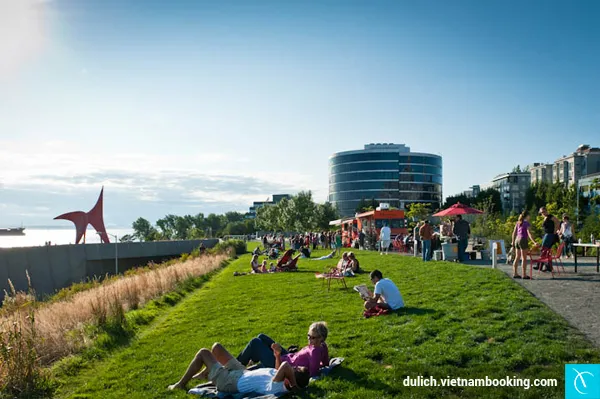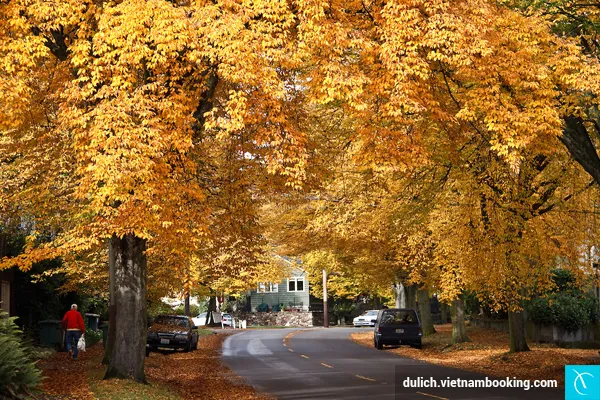Seattle, a city celebrated for its distinctive coffee culture, cutting-edge technology, and breathtaking natural landscapes, harbors a lesser-known yet equally captivating charm: its Japanese gardens. Nestled within this vibrant urban center, these verdant oases offer tranquil retreats where visitors can immerse themselves in nature, admire the unique artistry of garden design, and delve into the profound philosophies of Japanese culture. Join “Du lịch khắp thế gian” (Travel the World) on a journey to explore the enchanting Japanese gardens of Seattle, an unmissable experience when visiting this beautiful city.
Seattle Japanese Garden: An Artistic Masterpiece in the City
Located within the expansive Washington Park Arboretum, the Seattle Japanese Garden is considered one of the most authentic and beautiful Japanese gardens in North America. Established in 1959, this 3.5-acre garden is a harmonious blend of the natural beauty of the Pacific Northwest and traditional Japanese garden aesthetics.
Stepping into the Seattle Japanese Garden is like entering another world, completely removed from the city’s hustle and bustle. The central Kiyomizu-dera Pond, inspired by the famous Kiyomizu-dera Temple in Kyoto, is the heart of the garden. The still water reflects the lush greenery and graceful stone bridges, creating a picturesque and serene setting.
A defining feature of the Seattle Japanese Garden is the diversity of its Japanese garden elements. From winding paths that meander through the landscape, artificial hills covered in vibrant moss, to antique stone lanterns and traditional teahouses, every detail is meticulously crafted, reflecting the essence of Japanese culture.
The Seattle Japanese Garden is not just a place for sightseeing; it’s a space for experiencing and learning about Japanese culture. Visitors can participate in traditional tea ceremonies, attend Ikebana flower arranging classes, or simply stroll leisurely, listening to birdsong and embracing the garden’s tranquility.

The Seattle Japanese Garden is open year-round, each season offering a unique beauty. Spring brings a vibrant display of cherry blossoms and azaleas. Summer envelops the garden in lush greenery and cooling shade. Autumn paints the landscape in warm hues of red and gold as maple leaves change color. Winter cloaks the garden in a serene, contemplative beauty with a blanket of white snow.
Kubota Garden: A Harmony of Nature and Art
Another must-visit destination on your Japanese garden tour in Seattle is Kubota Garden. Situated in South Seattle, Kubota Garden is a 20-acre public garden created by the Kubota family, Japanese-American immigrants.
Kubota Garden deviates from the traditional Japanese garden blueprint, showcasing a distinctive style that beautifully merges Japanese elements with the natural splendor of the Pacific Northwest. The garden is divided into various areas, each with its own theme, ranging from tranquil karesansui (dry landscape) gardens to babbling brooks and vibrant flower gardens.
The highlight of Kubota Garden is its magnificent man-made waterfall cascading into a clear pond. Surrounding the pond are winding trails, rustic wooden bridges, and charming gazebos, creating an ideal space for leisurely walks and relaxation.
Kubota Garden is also renowned for its unique and diverse collection of bonsai trees. These meticulously cared-for bonsai, artistically shaped, demonstrate the skill and refinement of the gardeners.
More than just a beautiful garden, Kubota Garden carries profound historical and cultural significance. It stands as a symbol of the Kubota family’s perseverance, creativity, and love for nature, who overcame hardship and challenges to create a stunning green space for the community.

Kubota Garden is open to the public free of charge year-round. The garden frequently hosts cultural and artistic events, as well as outdoor concerts, attracting a large number of locals and tourists alike to visit and experience its beauty.
Waterfall Garden Park: A Verdant Oasis in the Urban Heart
If you seek a green and peaceful haven in the heart of downtown Seattle, visit Waterfall Garden Park. This small garden is tucked away amidst the towering buildings and bustling streets of the historic Pioneer Square district.
Waterfall Garden Park was designed by Japanese landscape architect Masao Kinoshita to commemorate the birthplace of the renowned courier company UPS (United Parcel Service). Built on a former parking lot, the garden presents an intriguing contrast between nature and urbanity.
The centerpiece of Waterfall Garden Park is a 22-foot man-made waterfall cascading into a small pond. The soothing sound of flowing water creates a tranquil ambiance, drowning out the city’s noise. Surrounding the waterfall are large granite rocks, lush greenery, and stone benches for visitors to rest and unwind.
Waterfall Garden Park is an ideal green oasis to escape the hustle and bustle of the city. Visitors can come here to read, chat with friends, or simply enjoy the quiet and peaceful atmosphere.

Waterfall Garden Park is open to the public free of charge during daylight hours. The garden is a favorite spot for locals and tourists, especially during lunchtime, when people seek refuge here to relax and recharge.
Conclusion
A journey to explore the Japanese gardens of Seattle is a unique and memorable experience. From the magnificent and grand Seattle Japanese Garden, to the Kubota Garden that harmoniously blends nature and art, and the serene Waterfall Garden Park in the city center, each garden offers its own distinct beauty and emotion.
These Japanese gardens are not only captivating tourist destinations but also cultural bridges, helping visitors gain a deeper understanding of Japanese philosophy, garden design artistry, and the spirit of respecting nature. If you have the opportunity to visit Seattle, be sure to take the time to explore these verdant oases, to rediscover balance and tranquility in your soul amidst the modern rhythm of life.